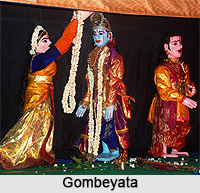 Gombeyata is the name for all varieties of puppetry in Karnataka. Researchers have identified seven such forms. Of these forms only two namely sutrada i.e. string and togalu i.e. leather still survive.
Gombeyata is the name for all varieties of puppetry in Karnataka. Researchers have identified seven such forms. Of these forms only two namely sutrada i.e. string and togalu i.e. leather still survive.
The string puppets are 35-50 cm in height and made of soft wood, sometimes with rags stuffed inside. Each marionette is manipulated with six strings attached to a rod. A performance needs at least twenty puppets, and special ones with moveable jaws and multiple heads are added attractions. Normally two or three persons manipulate the puppets, accompanied by one helper and three or four musicians. The stage is a box closed on three sides with an opening 6 m in front. The show, usually lit by oil lamps now with electric bulbs, lasts the whole night. The general mode of performance is based on the predominant theatrical form in the area. Thus Gombeyata of the western districts closely follows Yakshagana, hence is called Yakshagana Gombeyata. The respective conventions, stagecraft, and scripts of these dominant forms are followed, with minor adaptations. In the late twentieth century, U. Kogga Devanna Kamath and M. R. Ranganatha Rao contributed significantly to string puppetry.
Leather puppetry is another art of puppetry in India that is scattered in several pockets. This is exclusively performed by the Killekyata tribe, for whom it is both a ritual duty and partly a means of livelihood. A typical troupe is a Killekyata family itself; each member assigned a playing, speaking, or singing role. The puppets come in two sizes. The sizes can be mentioned as about 2 m in height and about 1 m or less. They are two-dimensional cutouts of translucent goatskin, meticulously carved with designs and brightly coloured with herbal pigments. They contain several moveable parts operated by thin bamboo sticks. They move behind an lm-by-2 m white screen spread out by bamboo poles, with an oil lamp projecting their shadows. Each overnight show employs at least fifty puppets. Some of them represent entire groups like Rama`s monkey army. It creates a magical shadow play embellished with music and witty speech. Themes and conventions closely resemble those in Doddata or Mudalapaya Bayalata, with some interesting variations. As for example a stock character, the coarse Killekyata, keeps intervening at several points with rough and earthy humour. This earthiness is one main reason for the relative popularity of leather puppetry in Karnataka as well.




















